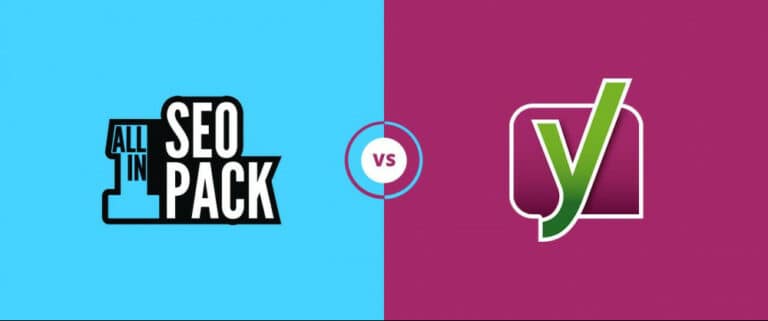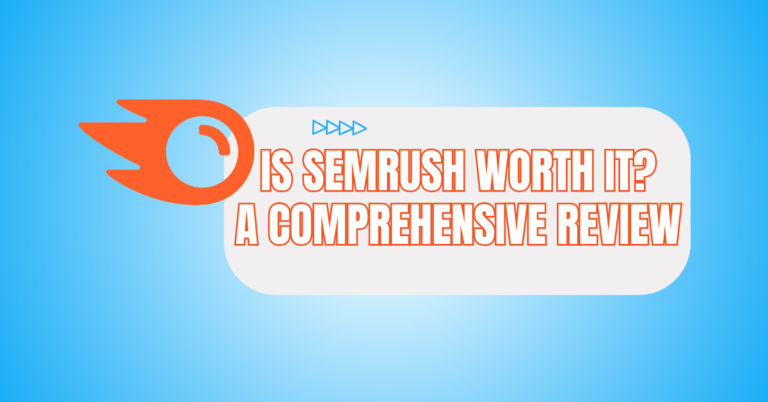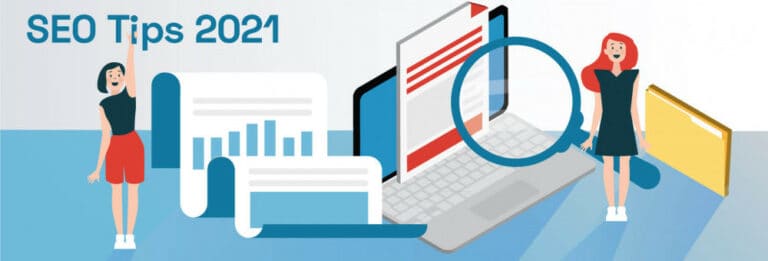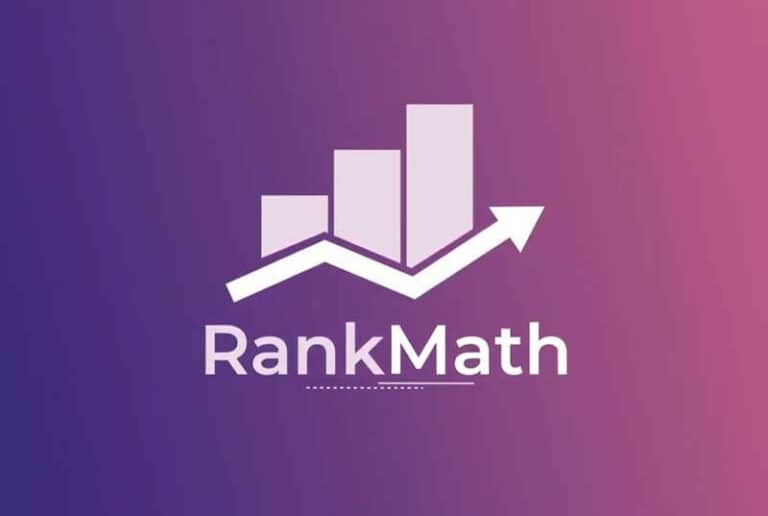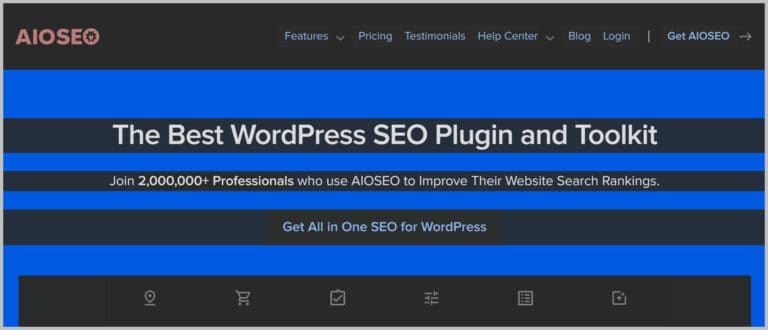Top 7 Types Of SEO Optimization
Top 7 Types Of SEO Optimization To Skyrocket Your Website's Success
Making your website more visible and accessible to your target audience mostly depends on search engine optimization, or SEO.
By understanding the different types of SEO optimization, you can improve your site's ranking on search engines like Google.
The four primary SEO categories—on-page, off-page, technical, and local—will be discussed in this article, and how important each is to increasing traffic, building credibility, and attaining long-term success online.

Introducing Types Of SEO Optimization
With Search Engine Optimization (SEO), a website's presence in search engine results can be improved. To succeed, it's essential to understand the various types of SEO optimization, each targeting different aspects of your site’s performance and reach.
On-Page SEO
On-page SEO refers to optimization tactics implemented directly on the website's pages. Key components include:
1. Keyword Optimization
Keyword optimization identifies the search engine terms and phrases your target audience uses and naturally integrates them into your website's content.
Begin by performing keyword research to identify high-volume, low-competition terms pertinent to your niche using tools such as Ubersuggest or Google Keyword Planner.
Then, strategically insert these keywords into your page titles, headers, URLS, meta descriptions, and throughout the content.
Ensure the usage feels natural and enhances readability. Avoid overusing them (keyword stuffing), as that can hurt SEO. Effective keyword optimization improves your site’s visibility on search engines, drives targeted organic traffic, and connects your content to users’ search intent.
2. Content Quality
SEO and audience retention both depend on high-quality content. Research your audience’s needs and create original, in-depth, solution-oriented content.
Structure your content with clear headings, short paragraphs, and multimedia like images or videos to enhance readability. Use accurate information, cite credible sources, and ensure grammatical correctness.
Refresh outdated content regularly to maintain relevance. Good content improves your search engine ranking, fosters visitor trust, lengthens visitors' stays on your website, lowers bounce rates, and draws backlinks, which raises your authority and natural visibility.
3. HTML Tags
Despite not directly affecting SEO, HTML tags are crucial for structuring material, indicating relevancy to search engines, and keeping your Craft meta descriptions under 160 characters to encourage clicks.
Use <H1> for your main headline, and <H2> to <H6> to structure subtopics. Images should always have descriptive alt text to increase accessibility and aid search engines in deciphering visual components. Proper HTML tagging enhances content clarity, boosts search visibility, and improves device user experience.
4. Internal Linking
Internal linking helps search engines efficiently explore your website by connecting pages and guiding users. Start by identifying high-traffic or cornerstone content and linking to it from relevant articles using descriptive anchor text.
Users will be more inclined to explore more pages and remain on your site longer due to the logical flow this produces. It also distributes link equity, boosting the authority of linked pages.
Want to Start Making Money Online?
Try My #1 Recommendation Program!
Proper internal linking improves crawlability, aids indexing of deeper content, and strengthens your site’s SEO by building a structured, interconnected content network.
5. User Experience (UX)
User Experience (UX) design is one of the crucial types of SEO optimization that ensures visitors stay longer and interact more with your website.
Ensure your site loads quickly—compress images, minimize code, and use reliable hosting. Structure navigation logically with clear menus and internal links.
Choose legible fonts, use ample white space, and maintain a consistent design theme. A strong UX keeps users engaged, reduces bounce rates, and increases dwell time and page views.
These positive engagement signals tell search engines your site is valuable, improving your rankings and organic traffic over time.

Off-Page SEO
Any activity outside your website that affects your results is off-page SEO.
1. Backlink Building
Backlink building involves acquiring hyperlinks from reputable websites pointing to your content. Start by creating high-quality, shareable content like blogs, infographics, or guides.
Contact relevant websites, blogs, or influencers for guest posting or resource mentions. Use tools like Ahrefs to identify backlink opportunities and monitor your link profile.
Aim for links from authoritative, niche-related sites to boost trustworthiness. Avoid spammy or paid links, as they can hurt rankings.
High-quality backlinks serve as endorsements, telling search engines that your website is reliable and trustworthy. This greatly enhances your SEO and raises your site's ranking in search results.
2. Social Media Engagement
Social media engagement is one of the consequential types of SEO optimization that boosts content exposure and drives organic traffic through increased sharing and visibility.
Start by sharing blog posts, videos, and infographics on platforms like Facebook, X (formerly Twitter), LinkedIn, and Instagram. Use relevant hashtags, compelling captions, and eye-catching visuals to increase interaction.
Participate in discussions and reply to followers' remarks to foster community and trust. Consistently posting and collaborating with influencers or brands can expand your reach.
Increased social signals—likes, shares, and comments—don’t directly impact rankings but boost traffic and brand awareness, indirectly supporting your SEO efforts by attracting backlinks and longer user sessions.
3. Brand Mentions
Brand mentions occur when your business is referenced online without a direct backlink. These can appear in blog posts, news articles, forums, or social media discussions.
To encourage mentions, focus on providing valuable content, participating in industry discussions, and building strong relationships with media and influencers.
Monitor your brand using tools like Google Alerts or Mention to track and engage with mentions. While unlinked, brand mentions contribute to your online presence and help establish authority and trustworthiness.
Search engines may view frequent, positive brand mentions as a signal of credibility, which can indirectly boost your site’s SEO performance.
4. Guest Blogging
Writing content for reputable websites in your area is known as guest blogging, and it's a great way to get visibility and backlinks.
Start by identifying reputable blogs that accept guest posts, then pitch relevant, high-quality content ideas. Once received, write informative, original content included within your site.
Want to Find Out How To Start Your Home-Based Business?
Try My #1 Recommendation Platform!
This process positions you as an expert, drives targeted traffic, and earns valuable backlinks—one of the strongest SEO signals.
Furthermore, guest writing exposes your business to a broader audience and fosters connections with other industry experts. Over time, this boosts your domain authority, search rankings, and credibility in your field.
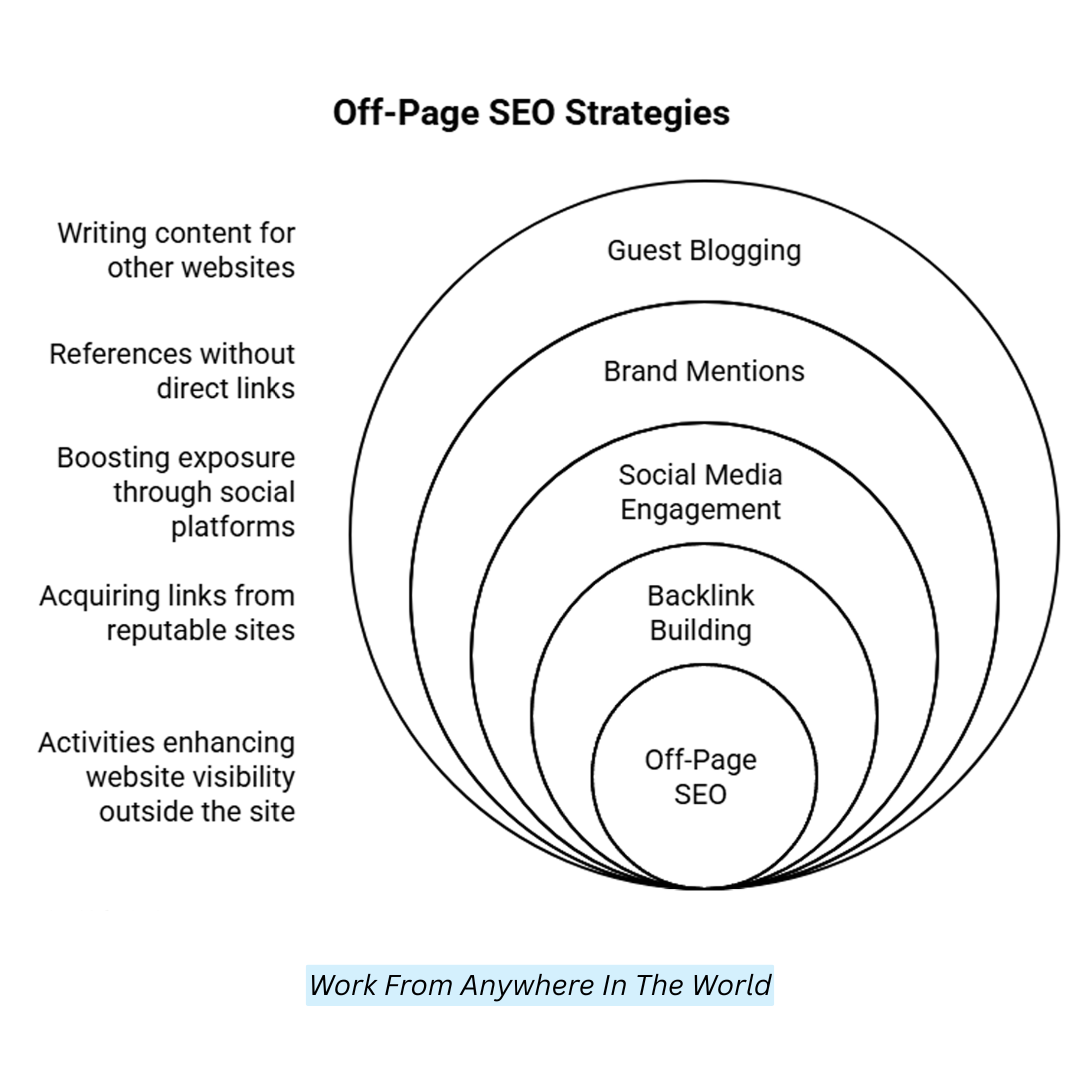
Technical SEO
Technical SEO involves optimizing the infrastructure of your site for search engines.
1. Website Speed
Website speed is a critical SEO factor that affects user satisfaction. To optimize speed, compress images, use lazy loading, enable browser caching, and minimize code (HTML, CSS, JavaScript).
Utilize a material Delivery Network (CDN) to effectively distribute material and pick a dependable, quick hosting company.
Use resources like GTmetrix or Google PageSpeed Insights to test your website frequently to find performance problems.
A faster site reduces bounce rates, keeps users engaged longer, and improves conversion rates. Since Google prioritizes speed in its algorithm, optimizing load times directly contributes to higher search engine rankings and better user retention.
2. Mobile Optimization
Mobile optimization is among the essential types of SEO optimization, ensuring your site delivers a seamless experience on all devices to improve rankings and user satisfaction.
Start using responsive design, automatically adjusting your site's layout to fit any screen size. Ensure buttons are simple to tap, content loads rapidly, and text is readable without zooming. Test your site with Google’s Mobile-Friendly Test tool and fix any usability issues.
Prioritize mobile speed using compressed media and streamlined code. Mobile-optimized sites enhance user experience, lower bounce rates, and comply with Google's mobile-first indexing.
This boosts search rankings and expands your website's audience reach.
3. Crawlability And Indexing
Crawlability and indexing determine how easily search engines can find and understand your website content. Start by creating a robots.txt file to control which pages should or shouldn’t be crawled.
Then, generate an XML sitemap and submit it through Google Search Console to help search engines locate all your important pages.
Are You Tired Of Scams?
Want to Start Making Money Online?
Use structured data, or schema markup, to provide more context to your content, including reviews, events, and products.
With these tools, search engines may more easily comprehend and present your website in search results, increasing visibility, indexing effectiveness, and rich snippet click-through rates.
4. HTTPS Security
HTTPS security protects user data and is a confirmed Google ranking factor. To implement it, purchase an SSL certificate (many hosting providers, including Wix, offer free SSL).
Once installed, ensure all pages redirect from HTTP to HTTPS. Update internal links and check for mixed content issues using tools like Why No Padlock.
A secure website builds trust, especially for eCommerce or data-collection sites, reassuring visitors that their information is safe.
Google prioritizes HTTPS websites in search results, so enabling it not only enhances security but also contributes to higher rankings and improved user confidence and retention.
5. Fixing Errors
Fixing SEO errors like broken links, 404 pages, and duplicate content is crucial for maintaining site health and improving rankings.
Start using tools like Google Search Console or Screaming Frog to identify issues. Fix broken links by updating or redirecting them using 301 redirects. Resolve 404 errors by restoring or redirecting the missing pages.
Address duplicate content by consolidating similar pages or using canonical tags. These fixes enhance user experience, prevent loss of page authority, and ensure search engines can crawl and index your site efficiently, leading to better visibility and higher rankings.
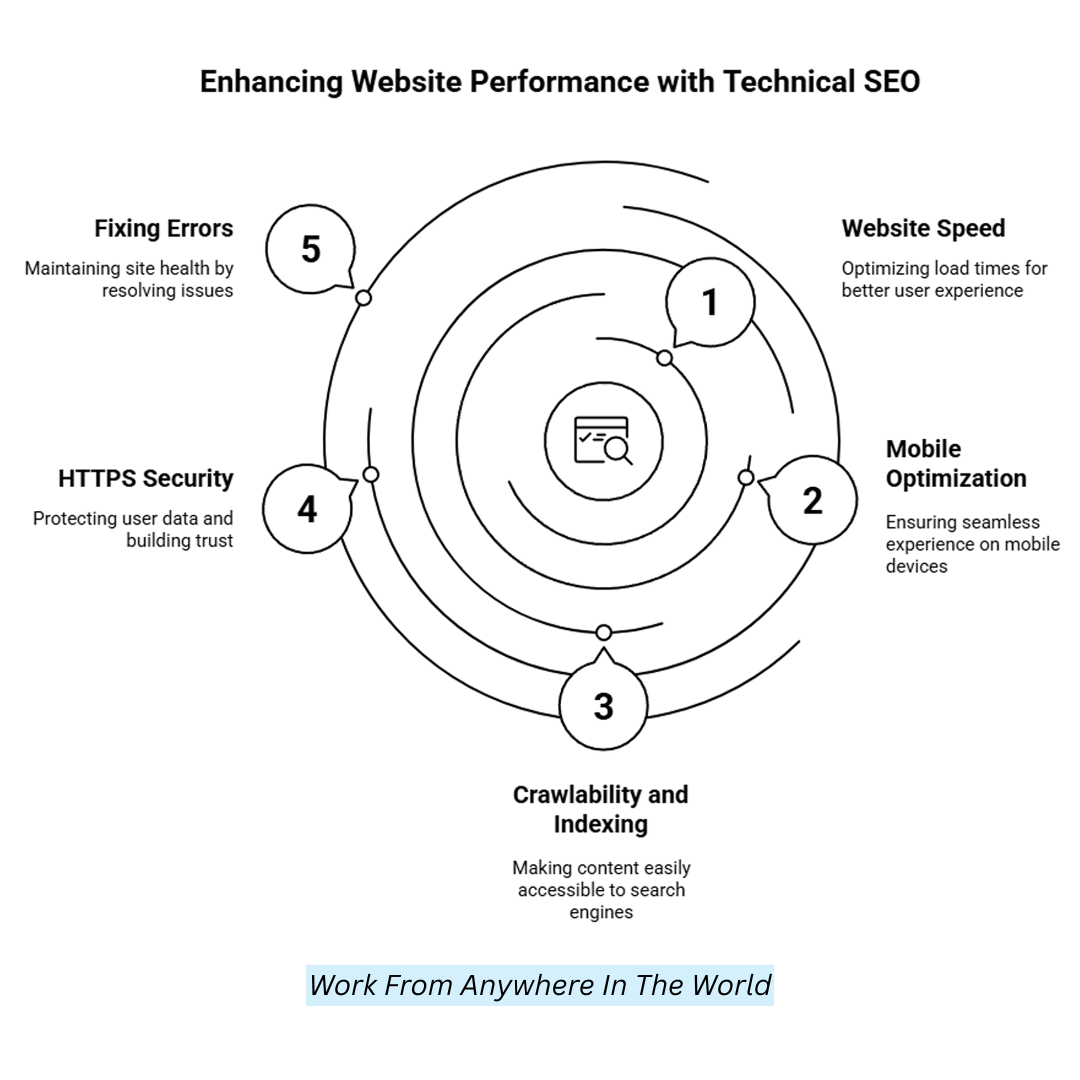
Local SEO
Businesses can use local SEO to appear in local search results.
1. Google Business Profile
Claiming and optimizing your Google Business Profile is one of the crucial types of SEO optimization that helps improve local search visibility and attracts more customers.
Start by claiming your listing through Google My Business. Incorporate precise information such as your company name, address, phone number, website, hours, and services. Add high-quality images, encourage customer reviews, and regularly update your profile with posts or offers.
An optimized profile increases your visibility in local search results and Google Maps, enhances trust, and provides customers with all the information they need, improving engagement and driving more foot traffic or online conversions.
2. NAP Consistency
Making sure that your business's name, address, and phone number appear consistently on all websites, social media profiles, and online directories is known as NAP consistency.
Start by verifying your NAP details on your website, Google Business Profile, and local citations like Yelp, Yellow Pages, and industry-specific directories.
Consistency across platforms helps search engines verify your business’s legitimacy and improves your local SEO ranking. Inaccurate NAP data might harm your visibility by confusing users and search engines.
Ensuring NAP consistency builds trust, boosts local search performance, and makes it easier for potential customers to contact your business.
3. Local Citations
A local citation is when your business's name, address, and phone number (NAP) are included online in several directories and websites, including Yelp, TripAdvisor, and the Yellow Pages.
Start by submitting your business details to relevant directories and ensuring accurate and consistent information. This process helps search engines verify your business’s existence and relevance in local searches.
The more authoritative and relevant the directory, the greater the impact on local SEO. Local citations increase visibility, improve local rankings, and drive more traffic to your site, helping potential customers find your business more easily.
4. Reviews And Ratings
Promoting glowing testimonials from pleased clients is an excellent method to increase your company's legitimacy and internet visibility.
Start by offering top-notch goods or services, inevitably resulting in favourable comments. Request client evaluations on websites like Trustpilot, Yelp, and Google.
Want To Learn How To Create Your Own Website And Online Business?
Try My #1 Recommendation Training And Hosting Platform!
Send follow-up emails or include links to make it simple. Positive reviews improve trust, influence purchasing decisions, and enhance local search rankings.
They also signal to search engines that your business is reputable, ultimately driving more traffic, improving brand reputation, and increasing conversions.
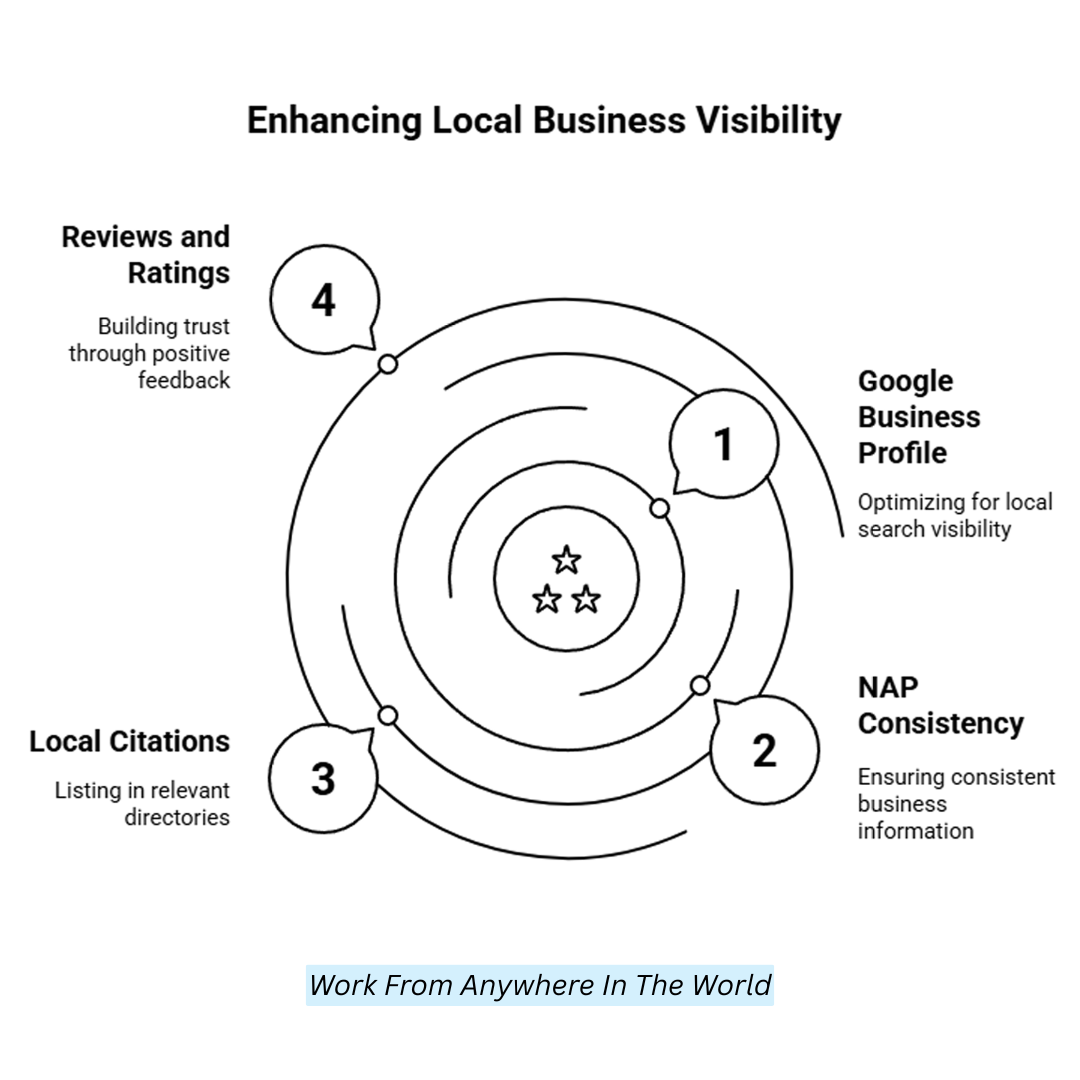
Mobile SEO
With mobile-first indexing, your mobile site matters more than ever.
1. Responsive Design
Responsive design is one of the essential types of SEO optimization, ensuring your website performs well across all devices and improves user experience.
Begin using a flexible layout with scalable images and media that automatically resize to fit different screen sizes. Incorporate CSS media queries to customize the appearance for various devices.
This method improves the user experience by offering a consistent design across all devices and simple navigation. Mobile-friendly websites are given preference by Google in search results.
Therefore, responsive design can boost SEO effectiveness. Additionally, it reduces bounce rates, increases engagement, and encourages extended visits, contributing to better overall website performance.
2. Touch-Friendly Navigation
Touch-friendly navigation ensures that buttons, tablet menus, and interactive elements are easy to use on tablets by designing large, well-spaced buttons that can be tapped with a finger without accidental clicks. Avoid using hover-based interactions, as they don't translate well to touchscreens.
Use mobile-optimized menus like collapsible or hamburger menus for cleaner interfaces. This design enhancement makes your content more mobile-friendly, less frustrating, and more engaging for users.
Search engines recognize mobile usability as a ranking factor, so enhancing touch navigation improves user experience and SEO performance on mobile devices.
3. Loading Time On Mobile
Optimizing loading time on mobile devices is essential for retaining users and boosting SEO. Start by compressing images and videos to reduce file size without compromising quality.
Use modern formats like Webp, and enable lazy loading so media only loads as users scroll. Minimize unnecessary scripts, use browser caching, and implement a content delivery network (CDN) for faster delivery.
Tools like Google PageSpeed Insights can help you identify issues. Faster mobile load times reduce bounce rates, enhance user satisfaction, and are favoured by Google’s mobile-first indexing, improving your rankings and overall mobile performance.
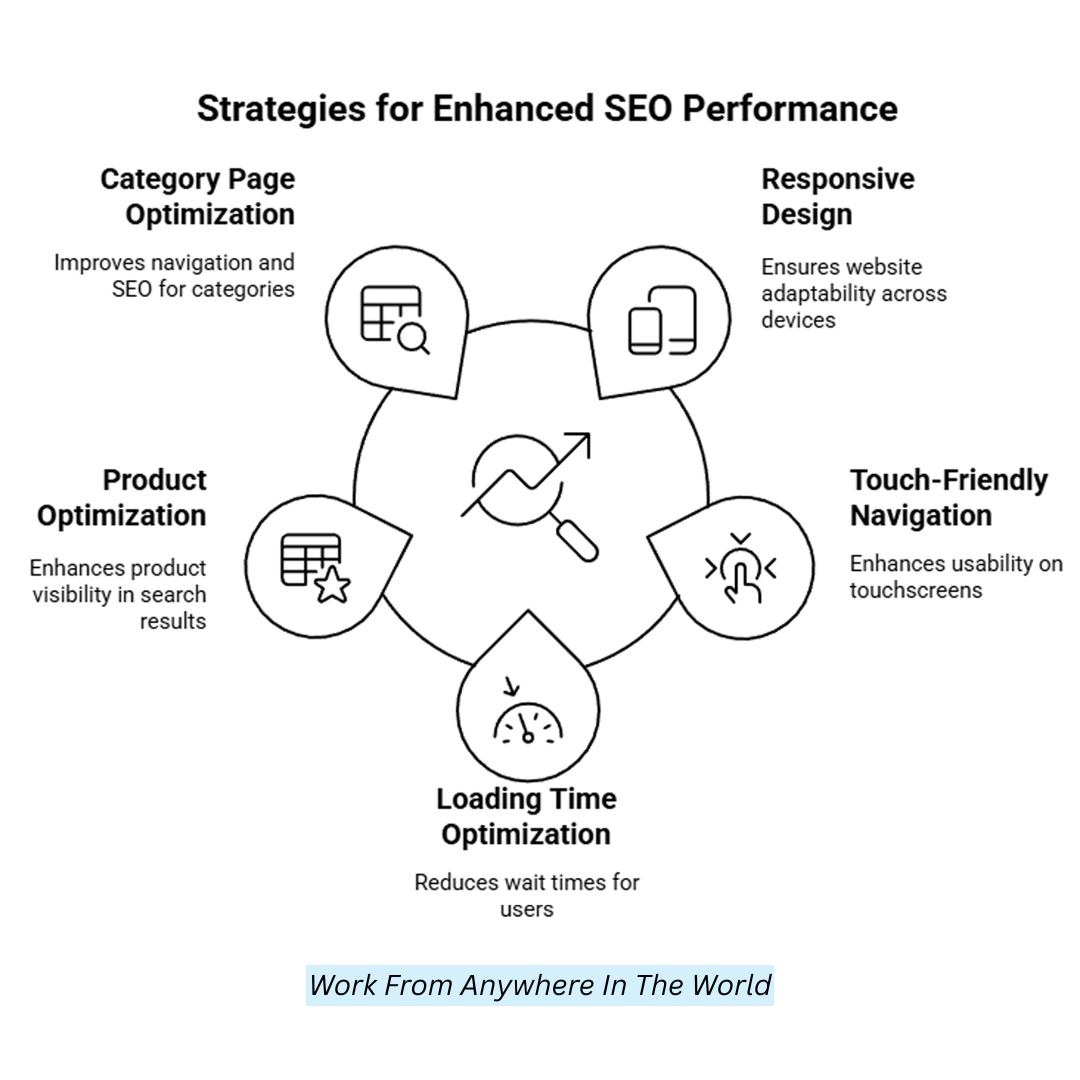
E-Commerce SEO
E-commerce websites need specialized SEO for product pages and shopping experiences.
1. Product Optimization
Product optimization is a key component of SEO that helps eCommerce products rank higher in search results and attract more potential buyers.
Start by crafting clear, keyword-rich product titles and detailed descriptions highlighting benefits, features, and use cases. Add high-quality images and videos for better engagement.
Implement schema markup (Product, Offer, Review) to help search engines display rich snippets like price, availability, and ratings.
This improves click-through rates and makes your listings stand out. Optimized product pages improve SEO visibility, build buyer confidence, reduce bounce rates, and increase conversion by offering users the precise information they seek.
2. Category Pages
Optimizing category pages improves navigation and SEO performance, especially for eCommerce sites. Start by crafting keyword-rich titles and meta descriptions that reflect the product grouping. Use clean URLS and add relevant content at the top of the page to explain what the category offers.
Implement filters (e.g., size, brand, colour) that generate crawlable URLS, and use breadcrumbs to help users and search engines understand the page structure.
Include internal links to key subcategories or best-selling products. This method improves the user experience, lengthens visitors' stays, and facilitates better content crawling and indexing by search engines.
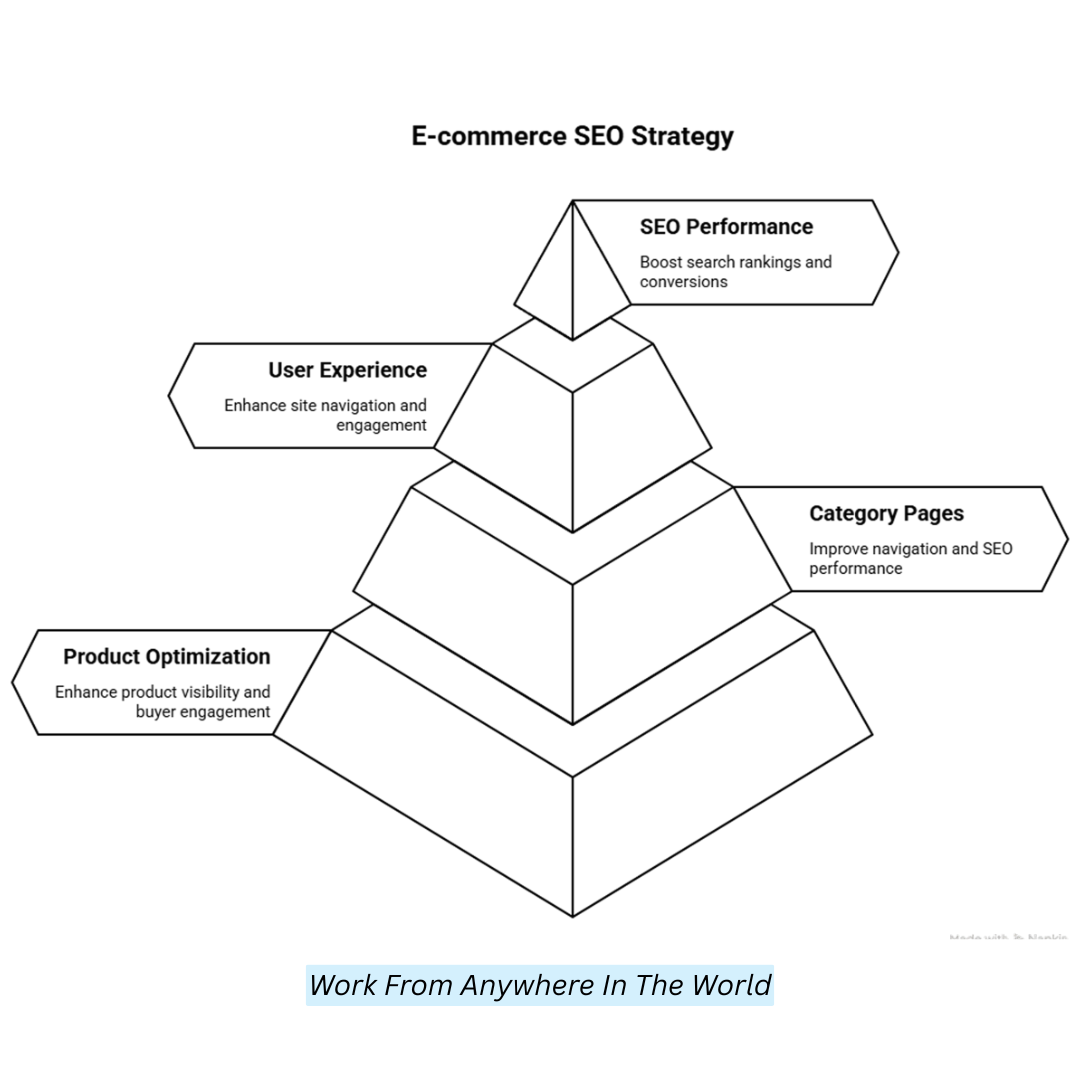
Conclusion
Understanding the different types of SEO optimization—on-page, off-page, technical, local, and mobile—empowers you to build a well-rounded strategy that drives traffic and boosts visibility.
Each type works together to improve user experience, increase rankings, and attract the right audience. By consistently applying these practices, you lay a strong foundation for long-term online success.
Whether you're a beginner or scaling your efforts, mastering SEO optimization is key to staying competitive in the digital landscape.
I trust you enjoyed this article about Top 7 Types Of SEO Optimization To Skyrocket Your Website's Success. Please stay tuned for more articles. Take care!
JeannetteZ
Want to Learn How to Build Your Own Home-Based Online Business And Start Making Money Online From Your Comfortable Couch?
Try Wealthy Affiliate!
Your Opinion Is Important To Me
Do you have thoughts, ideas, or questions? I would love to hear from you. Please share your questions, experiences, remarks, and suggestions about Top 7 Types Of SEO Optimization To Skyrocket Your Website's Success in the comments below. You can also email me at Jeannette@WorkFromAnywhereInTheWorld.com.
Disclosure
This post may contain affiliate links. I earn from qualifying purchases as an Amazon Associate and through other affiliate programs. Please read my full affiliate disclosure.
You may also enjoy the following articles:
Wealthy Affiliate Coupons For Premium Memberships
Wealthy Affiliate Review – Scam or Legit? The Truth Exposed
An Insider Wealthy Affiliate Review
Small Business Success Secrets
How To Promote Affiliate Links


